Are you looking for something new and exciting to add to your workout? Look no further! Lateral raises are a perfect way to give your workouts that toning boost they need, as well as keep them fresh and fun. Not only do they work wonders for your shoulders, but lateral raises target other muscle groups like the biceps and triceps too. Plus, these exercises come with various variations so there’s always room for experimentation!
It may be the ideal technique for you. Lateral raises can work wonders on achieving stronger and fuller shoulders with plenty of variations and forms available to try out! In this post, we will discuss how they are done. The common variations that can take place, and how they can effectively be included in any fitness routine. So if you’re ready for a challenge then read on!
What Is Lateral Raises
Lateral raises are one of the most common exercises for strengthening and toning the shoulders. It mainly works the lateral deltoids which are responsible for controlling lateral movements of the shoulder joint. The lateral raise is done by lifting your arms out to the sides. Parallel to the floor, and then slowly lowering them down again. It is important to ensure that you maintain good form throughout this exercise. As it can lead to incorrect movement and unnecessary strain on the shoulder.
Variations In Lateral Raises
There are a variety of lateral raise variations you can try to keep your workouts interesting and effective. Here are some of the common lateral raise variations:
Seated Lateral Raises
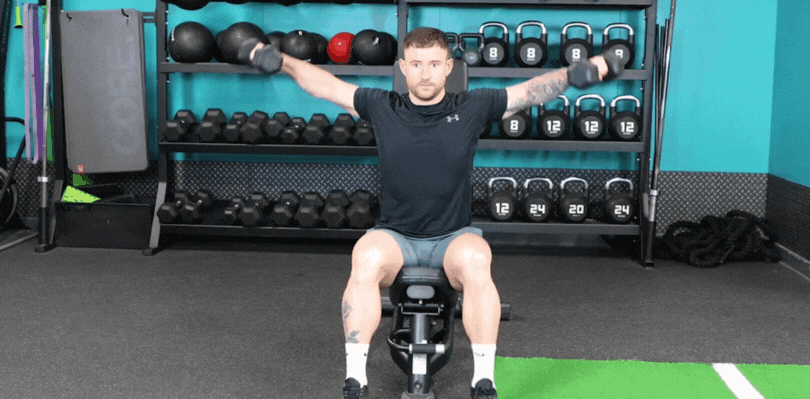
This variation is done while seated on a bench or chair. Start by holding dumbbells with your arms straight down at your sides, then slowly lift them up to shoulder height and lower them back down again.
How Seated Lateral Raises Work:
This variation is a great way to target the lateral deltoid muscle without putting too much strain on your back and core. By being seated, it helps you stay in an optimal position which also keeps your posture correct while performing them.
Bent Over Lateral Raises
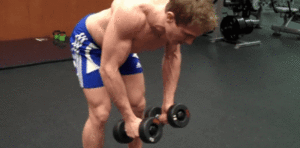
For this exercise, start by bending at the waist and keeping your back straight. Make sure to keep a slight bend in your knees as you hold the dumbbells with your arms extended down toward the ground. Then, slowly raise them up to shoulder height and lower them back down again.
How Bent-Over Lateral Raises Work:
This variation works on multiple muscle groups at once. As you’re bent over, your core and lower back are engaged and working to keep your posture correct. At the same time, your lateral deltoids are getting a good workout as they raise and lower the weights.
Dumbbell Lateral Raises
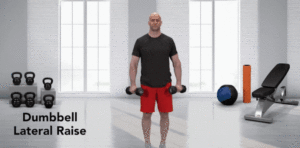
This variation is similar to the seated lateral raises, however, this time you’ll be using a dumbbell in each hand instead of one. Start by sitting on a bench or chair and holding your arms straight down at your sides with the dumbbells. Then, slowly lift them up to shoulder height and lower them back down again.
How Dumbbell Lateral Raises Work:
Using two dumbbells instead of one provides an even workout for both sides of your body. It also works on multiple muscle groups as the lateral deltoids are engaged in the movement, while other muscles like the biceps and triceps come into play to help with stability and control.
Standing Lateral Raises
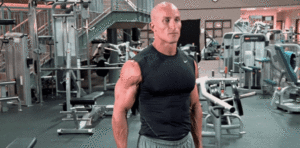
This is a classic lateral raise variation that involves standing with your feet shoulder-width apart. Again, you will be holding dumbbells in either hand and raising them up to shoulder height before lowering them back down. Be sure to keep your arms straight throughout this exercise for maximum effectiveness.
How Standing Lateral Raises Work:
This lateral raise variation is great for targeting the lateral deltoids and works other supporting muscles such as your biceps and triceps. As you are standing, it helps to engage your core muscles to keep your posture correct which also adds an extra layer of stability for the lateral raises.
Single-Arm Lateral Raise
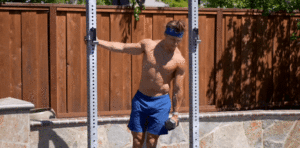
This lateral raise variation is done with one arm at a time. Start by holding the dumbbell in one hand and slowly lifting the arm out to the side. Parallel to the floor, before lowering it back down again. Be sure to keep your arms straight throughout this exercise for maximum effectiveness.
How Single-Arm Lateral Raises Work:
This lateral raise variation is great for focusing on one side at a time and allows you to really target the lateral deltoids. As you are using just one arm, it helps to engage your core muscles even more as they work to keep your balance and posture correct. These lateral raise variations are a great way to add variety and challenge to your workout routine. They can be done with dumbbells, resistance bands, or even just body weight so there’s something for everyone! Plus, they can help you target different muscles in your lateral deltoids while also engaging other supporting muscles for a full-body workout. Give them a try and see which one works best for you!
Effects And Benefits
- Doing lateral raises is a great way to isolate and target specific muscles in your deltoid. Also, engaging supporting muscles such as your biceps, triceps, and core.
- This exercise can be done with minimal equipment. Or even just body weight for a great workout that can be done anywhere.
- Doing them helps to improve shoulder stability which is important for overall shoulder health.
- Lateral raises can help to improve posture and reduce pain in the shoulder area as it strengthens and stabilizes the joint.
- Doing them regularly can help to strengthen the lateral deltoids which can lead to improved performance during other exercises. Such as overhead presses or push-ups.
Overall, they are a great exercise for targeting your deltoids and for improving shoulder stability, posture, and performance. Give them a try and see the benefits for yourself! By adding it to your workout routine you can target multiple muscles while also improving overall shoulder health. With so many variations available, there is something for everyone when it comes to lateral raises.
Tips For Beginners
- Start with lighter weights and focus on form and range of motion.
- Make sure to keep your core engaged and your shoulders down throughout the exercise.
- Try to do lateral raises in both directions (upward and downward) for complete muscle activation.
- Gradually increase the weight as you get stronger and more comfortable with the exercise.
- Focus on breathing and stay in control of the weight throughout the motion.
By following these tips, you can ensure that you are doing them properly and safely. Also, getting the maximum benefit from them. So give it a try today and see how they can help improve your overall shoulder health!
FAQs
Are dumbbell lateral raises good exercise or dangerous?
Dumbbell lateral raises can be a great exercise for targeting the deltoids. However, it’s important to use proper form and start with lighter weights. If done correctly, they are safe and effective for strengthening your deltoids.
What muscles do lateral raises work?
Lateral raises target primarily the deltoids, however, they also engage other supporting muscles such as the biceps, triceps, and core. This is an exercise that focuses on strengthening the lateral deltoids. It involves standing up straight with your arms by your side with lighter weights and proper form. It can be done safely and effectively for targeted deltoid strengthening.
What are lateral raises good for?
Lateral raises are great for targeting the lateral deltoids. Also, other supporting muscles such as the biceps, triceps, and core. They can help to improve shoulder stability which is important for overall shoulder health. However, it helps in improving posture and reducing pain in the shoulder area. They can also help to improve performance during other exercises such as overhead presses or push-ups. So give it a try and see the benefits for yourself!
